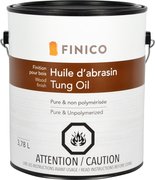- Do not rush and take all the time you need for each step, including preparation.
- Preparation is key to quality. Take care to respect every sanding grain when preparing the wood for its finish. Sanding represents 90% of the success in finishing. Even with the best finishing products available, your finish will be ordinary if the sanding is ordinary.
- Avoid single-coat oils, which are designed for speed and economy at the expense of aesthetics. Opt for an oil that can be applied in multiple coats. Plan for a minimum of 4 to 5 coats and more oil to build up a light film.
- Between each coat, you will need to manually sand the oil that has hardened for the time prescribed by the manufacturer (usually between 8 to 24 hours). Use a fine 600 to 800-grit sandpaper and a sanding block to avoid creating marks with your fingers.
- If you choose to polish with a sander and a white pad, do it when the oil has hardened. Otherwise, you will remove a small amount of oil, which is not ideal.
After following each of these steps, you will have achieved a smooth and silky finish with a lot of depth effect.
For an even more beautiful finish, let the oil harden to its best during the curing period recommended by the manufacturer (between 12 to 15 days). After this period, you can use a maintenance product recommended by the manufacturer to refresh the film and polish it with a white pad and your orbital sander. It is important to polish at a low or medium speed. This is the ultimate step for a flawless finish.
Each oil manufacturer has its distinct products. We used the Prato-Verde brand as an example. Do not hesitate to consult the product sheet to know the specific instructions from the manufacturer. Here are the links for Prato-Verde.








